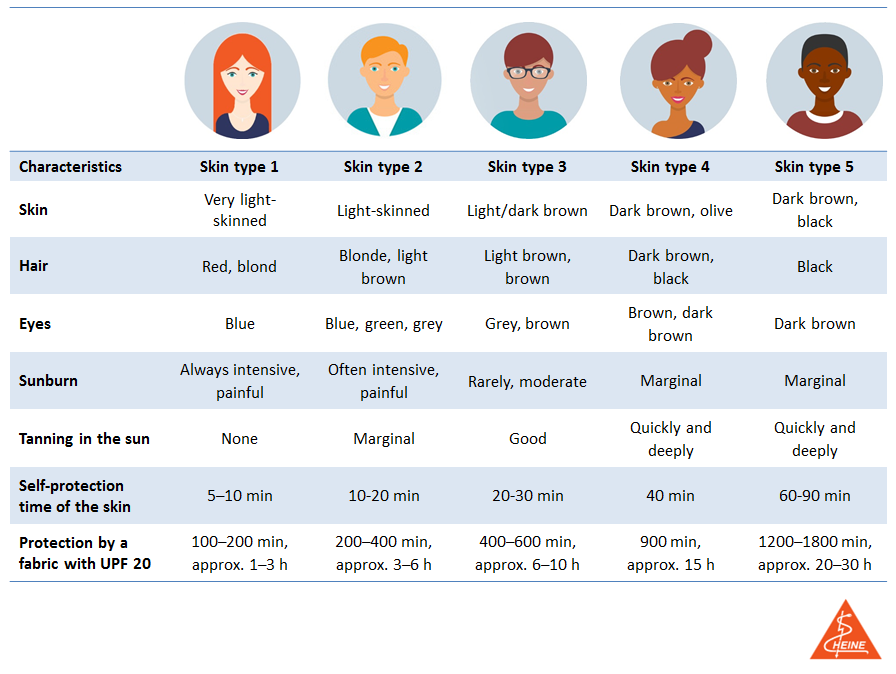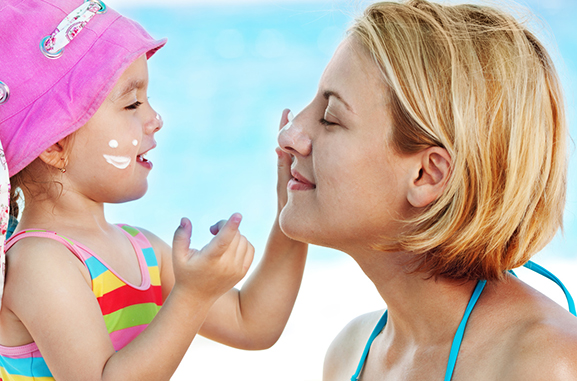PREVENTION
Determination of skin type
Fair skin with a high sensitivity to the sun is the most important risk factor for the development of skin cancer. The Fitzpatrick scale of skin type is divided into the following categories:

Additional risk factors
For malignant melanoma, the number of moles is a major risk factor. If there are more than 50 or 100 moles, there is a particularly high risk. This increases even more if there are moles greater than 5 mm in diameter. If both occur together, this is referred to as atypical nevus syndrome.
Immunosuppression is also becoming increasingly important. After an organ transplant or in the case of an autoimmune disease, immunosuppressants must often be taken over a lifetime. These people have a greatly increased risk of developing carcinoma!
Excessive exposure to the sun, outdoor sports, the increased use of tanning beds, and insufficient sun protection all contribute to the risk.
Sun protection
The most important measures for protecting against UV rays are avoiding the sun during the hours of peak intensity and wearing appropriate protective clothing.
Sunscreen is also important.
What does SPF mean?
The skin provides a certain degree of self-protection against the sun before it reddens and sunburn occurs. On average, this is 20 minutes for untanned skin. The sun protection factor indicates how much longer you can stay in the sun with sunscreen without getting burnt.
The most important protection against sunburn is the UVB filter. In Europe, the UVB protection factor has been specified in accordance with the standard of the Confederation of the European Cosmetics Industry COLIPA since 1997. The European SPF system uses the fair skin of a Northern European as the basis for measurement. The UVA protection factor must be at least one-third of the SPF.
Sunscreen with an SPF of 30 should therefore have a UVA protection factor (UPF) of at least 10. To test the UVA protection factor, a recommendation has been issued by COLIPA. Compliance with the required UVA protection is indicated by a special icon on the package. This consists of a circle containing the letters “UVA”.
It is important to determine one's self-protection time correctly. Wearing sunscreen with SPF 20, a very fair-skinned person with skin type I and a self-protection time of 3 minutes can only stay in the sun for 60 minutes without getting burnt.
To roughly determine how long you can stay in the sun, a simple SPF formula helps: Self-protection time × sun protection factor = the maximum possible time that can be spent in the sun per day without getting burnt. With a self-protection time of 15 minutes and an SPF of 20, you can spend 300 minutes (15 × 20) per day in the sun without getting burnt.
The prerequisite here is the right application of sunscreen. Other factors, such as sweating, contact with water, and reflections (e.g. 90% in water or in the snow and in sand) as well as a higher UV index (e.g. in the tropics, the Mediterranean, or high mountains) also play a role. Experts therefore recommend reducing the calculated protection time.
Types of sunscreen
Chemical sunscreens have conjugated double bonds that absorb UV radiation. In addition to protecting the skin, organic filters also protect the product itself (i.e. against UV-induced decomposition and fading). They are soluble, penetrate the top layer of the skin, and can trigger allergies and skin irritations.
Titanium oxide is often used as a physical (inorganic) sunscreen. It is insoluble and leads to whitening of the skin. It does not penetrate into the living skin and does not trigger allergic reactions. Zinc oxide is another inorganic filter.
To best cover the spectrum of UV rays and thereby provide the best possible sun protection, several sunscreens must be combined. Furthermore, photo-unstable filters can be protected by other filters. However, there can also be interactions between filters. Additives used include tocopherol (vitamin E), ascorbic acid (vitamin C), and flavonoids. They inhibit the formation of UVB-induced erythema and light-induced DNA damage
Adverse effects of sunscreen
Disturbance of vitamin D metabolism
Sun protection is very important, but so is sunlight. Sunrays activate the production of vital vitamin D in our skin. However, this can be inhibited by sunscreens. Many current studies suggest that low vitamin D levels can increase the risk of some cancers, cardiovascular diseases, metabolic diseases, and autoimmune diseases as well as susceptibility to infections.
To ensure sufficient vitamin D synthesis in the spring and summer, experts suggest exposing 20 per cent of the body surface (e.g. face and arms) to the sun three times per week, for half of the required to cause reddening of the skin, but not enough to cause sunburn. Vitamin D supplementation is only warranted in specific cases. These include the prevention of rickets in infants as well as patients with osteoporosis, chronic renal failure, and hypo-parathyroidism.
How do I protect myself properly?
Sunscreen must be applied liberally to the skin about 30 minutes before sun exposure. To achieve the specified protection, 2 mg/cm² of sunscreen must be applied. For an adult, this corresponds to three tablespoons. After swimming, the same amount of sunscreen should be reapplied, even when using waterproof sunscreen.
For textiles, there is also a value similar to the SPF in creams: The Ultraviolet Protection Factor (UPF). This indicates how much the garment shields against the sun. The value is always based on dry, normal fitting clothing; if the garment is wet or stretched, the value is reduced considerably.
A white T-shirt, for example, has a UPF of 10: this means that the garment only allows one-tenth of the solar radiation to pass through.
The UPF is not derived from the transparency of the garment.
